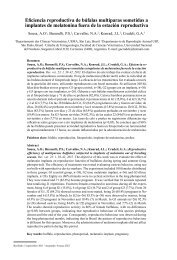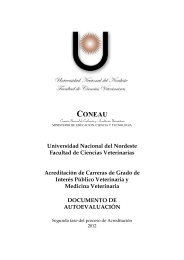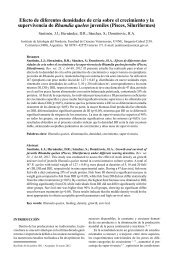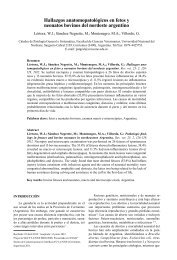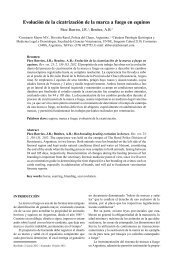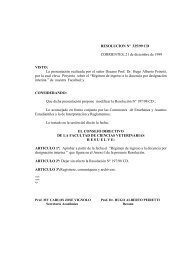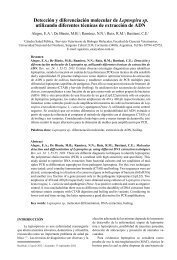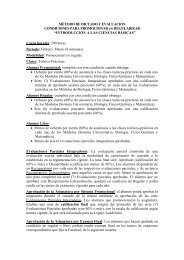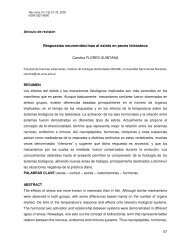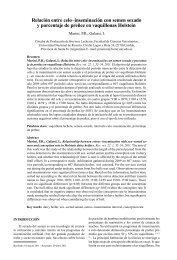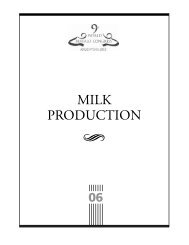REPRODUCTION - Facultad de Ciencias Veterinarias
REPRODUCTION - Facultad de Ciencias Veterinarias
REPRODUCTION - Facultad de Ciencias Veterinarias
You also want an ePaper? Increase the reach of your titles
YUMPU automatically turns print PDFs into web optimized ePapers that Google loves.
MATERIALS AND METHODS<br />
870<br />
<strong>REPRODUCTION</strong><br />
Forty milking buffalo (> 40 days after parturition) were assigned into two Groups (GnoeCG, n=20 and GeCG, n=20)<br />
according parity, days of parturition, body condition score, presence of dominant follicle and CL on Day -12 (D -12), D0<br />
and D9 (<strong>de</strong>vice removal). All buffaloes received an intravaginal progesterone <strong>de</strong>vice (1.0 g P4; DIB ® ) plus 2.0mg of<br />
estradiol benzoate intra-muscular (IM, RicBE ® ) at random stages of estrus cycle (D0). On D9, the DIB ® was removed and a<br />
luteolytic dose of PGF 2 a was administered (0.150 mg d-cloprostenol, Preloban ® ). On this day, buffalo in GeCG received<br />
400IU of eCG (Folligon ® ). After two days (D11), each buffalo received 10µg of GnRH (Conceptal ® ). Buffaloes were examined<br />
by ultrasonography (Mindray DP2200Vet, 7,5MHz) on D -12, D0 and D9 to verify the ovary status, from D11 to D14<br />
(12hs apart for 60 hours) to establish the moment of ovulation and on D16, D20 and D24 to measure the CL. All animals<br />
were bled in or<strong>de</strong>r to measure P4 level (RIA) on D16, D20 and D24. Data were analyzed by ANOVA. Results are presented as<br />
untransformed arithmetic means ± SEM.<br />
RESULTS AND DISCUSSION<br />
Results are shown in the table below.<br />
We evaluate the cyclic activities by the CL presence. It was verified by ultrasonographyc examination effected on D-12,<br />
D0 and D9 that approximately 50% of buffalo did’t has any CL. These females were consi<strong>de</strong>red in anestrous. According to<br />
Baruselli et al. 2 , the eCG effect is more pronounced as much as the inci<strong>de</strong>nce of anestrous, which was verified by the<br />
authors in Bos indicus.<br />
An the present study, no differences were found between groups regarding to the maximum diameter of dominate follicle,<br />
time and synchrony of ovulation, as that observed by Marques et al. 11 with cows, Baruselli et al. 3 with heifers and Porto<br />
Filho et al. 14 with buffalo. These results were different to the study of Cavalieri et al. 7 , that observed synchrony of<br />
ovulation in cows treated with P4+E2 and eCG.<br />
There were no differences between GnoeCG and GeCG on ovulation rate. However, the ovulation rate was numerically<br />
increased by eCG administration. In a previous investigation 3 , the employment of eCG increased the ovulation rate in<br />
heifers treated with P4 <strong>de</strong>vice. The low ovulation rate observed on GnoeCG is in agreement with the results obtained from<br />
buffalo in anestrous 1, 12, 16 . These authors didn’t use eCG associated to the ovulation synchronization protocol. Thus,<br />
although it constitutes in numeric increase, the utilization of eCG could promote better ovulation rates. The ovulation<br />
rates obtained by Singh et al. 15 with the utilization (58.3%) or not (33.3%) of eCG associated to P4 <strong>de</strong>vices in buffalo<br />
corroborates this hypothesis. Moreover, Singh et al. 17, 18 reported ovulation rates of 65% and 100% in buffalo that<br />
received eCG. On these both experiments, the authors verified that, neither buffalo presented ovulation on the groups<br />
without eCG.<br />
Proceedings 9 th World Buffalo Congress



